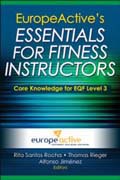
EuropeActive’s Essentials for Fitness Instructors contains the most comprehensive information and materials to guide fitness instructors towards best practices in helping clients achieve their fitness and health goals. Endorsed by EuropeActive, the fitness and health industry’s standard-setting authority in Europe, this manual is essential for all aspiring and qualified fitness instructors. This resource includes fundamentals and best practices of concepts, procedures, duties and responsibilities that individual and group fitness instructors perform on the job, covering the knowledge, skills and abilities needed for level 3 classification in the European Qualifications Framework (EQF), the baseline standards for registered fitness instructors in Europe. It provides mechanical and physiological information with hands-on techniques and practical examples to ensure that all fitness instructors deliver enjoyable and effective exercise sessions. Authored by renowned experts from all over Europe, EuropeActive’s Essentials for Fitness Instructors supports fitness instructors in promoting healthy lifestyle management and exercise adherence. Current and future fitness instructors will learn ideal ways to do the following: Build rapport and motivate participants. Identify participants’ motives and goals. Prepare appropriate choreography and use music. Provide effective and safe instruction; display and provide feedback on technique; and give advice on intensity, progressions and adaptations. Deliver excellent customer service and be a positive role model for participants in a clean and safe environment. The book begins by addressing customer service and communication. By first detailing the principles of customer service, the importance of communication in teaching and how to provide and receive feedback, fitness instructors can receive the information that follows with the proper mind-set. The book then delves into the core of physiology of individual fitness training, giving instructors a solid base from which to work with clients. Chapters on cardiorespiratory exercise and resistance exercise explain the science and training methods specific to each type of workout, including optimal warm-ups and cool-downs, adaptations and matters of safety. A chapter on principles of training, including progression, dose–response relationship, specificity, overload and reversibility, ties all of these concepts together. The second half of the book deals with effective group instruction, specifying how to incorporate the science of training with the art of class leadership. Preparing for, delivering and even ending a class come with particular strategies that will boost retention and results, and three chapters on music and choreography take the guesswork out of structuring a routine. Finally, a chapter on stress management offers an overview of the effects of stress on health, symptoms to watch for and relaxation techniques. The book concludes with an appendix of the EuropeActive EQF level 3 standards for reference. Aspiring and qualified fitness instructors have a duty of care to keep up with the latest health and fitness standards. EuropeActive’s Essentials for Fitness Instructors ensures instructors are properly serving their industry and their clients. For those who promote physical activity and healthier lifestyles, there is no other title with more authority in Europe. Contents Preface Chapter 1. Customer Service Thomas Rieger Principles of Customer Service Communicating About the Characteristics of Fitness Services Successful Customers Are Loyal Customers Managing Conflicts and Unsatisfied Customers Conclusion Chapter 2. Communication: Giving and Gaining Feedback Vera Simões and Rita Santos-Rocha Role of Communication in Teaching Importance of Communication in Teaching and Retaining Clients Giving and Gaining Feedback During Fitness Sessions Characteristics of Feedback During Fitness Sessions Conclusion Chapter 3. Cardiorespiratory Exercise Paolo Benvenuti and Silvano Zanuso, Cardiovascular Response to Exercise Warm-Up and Cool-Down Modifications to Allow for Individual Differences Cardiorespiratory Training Methods Dose–Response Relationship Based on Evidence Conclusion Chapter 4. Resistance Exercise Fernando Naclerio and Jeremy Moody Basic Movement Analysis for Exercise Performance and Technique Safety and Risk of Injury in Resistance Training: Posture, Body Alignment and Range of Motion Safe and Effective Spotting Techniques Warming Up for Resistance Training Training Status and Individual Differences in Resistance Training Practitioners Dose–Response Relationship for Different Resistance Training Goals Conclusion Chapter 5. Safe Progressive Exercise Planning Oscar Carballo Iglesias and Eliseo Iglesias-Soler Assessing Clients and Modifying Exercise Programmes Providing Proper Dose–Response Relationship for Individual Participants Communicating Effectively During Training Observing Physiological Changes Applying the Principles of Training Conclusion Chapter 6. Preparing Fitness Programmes Sonia García Merino and Susana Moral González Gathering Information Prior to the Start of Class Programme Exercise Goals and Benefits Programme Suitability Required Level of Fitness and Intensity and Impact Options Conclusion Chapter 7. Delivering a Group Fitness Class Simona Pajaujiene Helping Clients Choose Group Fitness Classes Core Concepts in Class Design Modifications to Planned Exercises Incorporating Functional Exercise Progression Intensity and Impact Options in Group Fitness Exercise Responding to a Medical Emergency Responsibilities of a Group Fitness Instructor Conclusion Chapter 8. Teaching Group Fitness to Music Rita Santos-Rocha and Nuno Pimenta Characteristics of Music Used in Fitness Classes Moving to the Beat Using Music to Motivate Participants Structuring a Group Fitness to Music Class Basic Moves for a Self-Designed Group Fitness to Music Class Leading Movement and the Leading Leg Verbally and Visually Cueing an Exercise Routine Conclusion Chapter 9. Music and Choreography Lenka Velínská Musical Structure Musical Tempo Use of Musical Structure Choreography Conclusion Chapter 10. Ending a Session Jana Havrdová and Nuno Pimenta The Instructor’s Role The Club’s Role Conclusion Chapter 11. Safety Guidelines for Group Fitness to Music Susana Moral González and Sonia García Merino Legal and Insurance Responsibilities Planning Class Activity Conclusion Chapter 12. Stress Management Techniques João Moutão and Susana Franco Stress and Distress Implications of Distress for Health and Well-Being Symptoms of Anxiety and Depression That May Require Professional Attention Relaxation Techniques Conclusion Appendix. EuropeActive Standards EQF Level 3 Fitness and Group Fitness Instructor References Index Contributors About EuropeActive
- ISBN: 9781450423793
- Editorial: HUMAN KINETICS PUBLISHERS
- Encuadernacion: Tela
- Páginas: 208
- Fecha Publicación: 01/01/2015
- Nº Volúmenes: 1
- Idioma:
